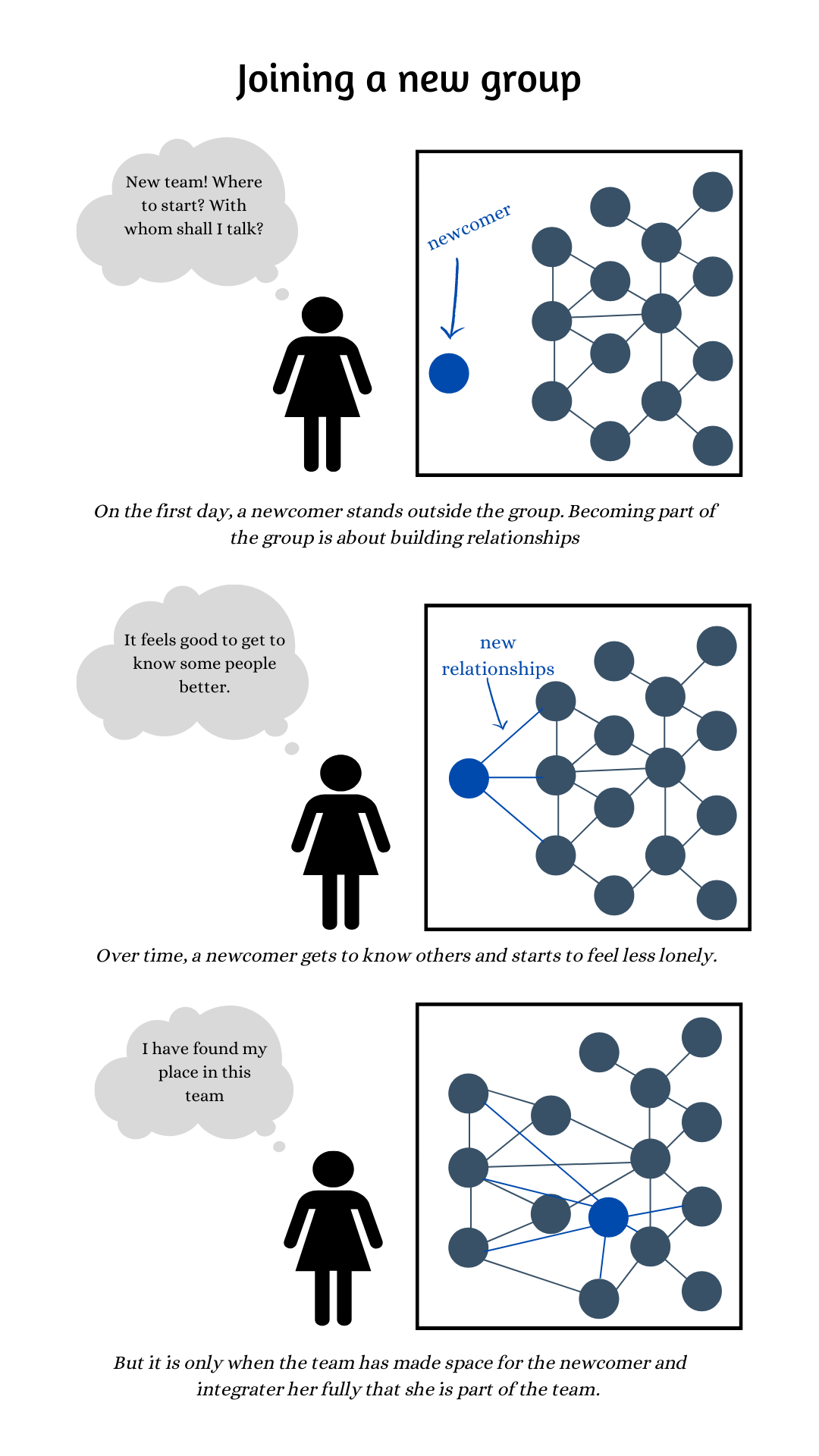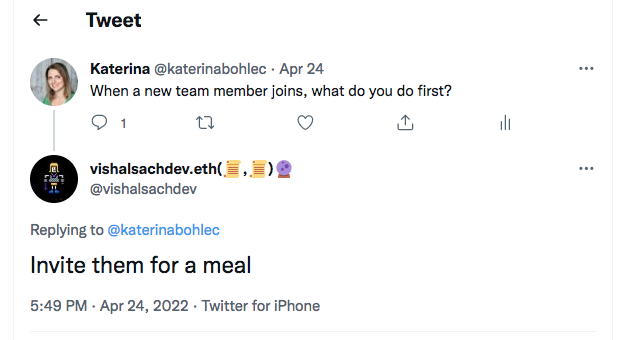Onboarding: forget about tasks; focus on talks
Onboarding serves two functions: Adding a new person to be part of the workflow and helping them become part of the team. The first aspect is easy, the second one is harder, but more important.
Working for a new team is like moving to a new city. You know the city's name (your team's name) and where you are living (your job). But you have limited information about other places in the new city (your team members and what they do). What is missing is a mental image of the city, a map that helps you not get lost (too often, anyway!). Like maps help us orient in a physical space, social relationship maps allow us to orient in a social space. They provide us with information about the inner workings of a team. To create this map, people need to socialize. This means the onboarding process should include time to talk with people.
It’s essential to have a socialization process for new hires. Feel free to picture dinner parties among elites where a newcomer is introduced to a social circle and builds connections (The Razor's Edge by W. Somerset Maugham illustrates this point very well. It's not long, I read it on a solo 2-day hike). An onboarding process that helps people build relationships sets the foundation for future problem solving and innovation.
Onboarding onto the role and the team
When hiring someone new, two things should be taken care of: The first one is obvious: onboarding the new hire onto their role. Ensure the person knows what they should be doing and is familiar with the established processes, giving them access to the tools they need to do the work.
The second factor is less obvious: New hires should integrate into the team. They need to become part of the team, not just another cog in the wheel. They need to build relationships with team members, figuring out each person's skills and what support they can get from them.
SHRM estimates that the cost of recruiting someone is three or four times the person's salary. Most of these costs are soft, ranging from collaborating with HR during the recruitment process to training and onboarding the new person. While it's common sense that new hires need to know what they should be doing, getting to know their team members will significantly impact their well-being and productivity.
When I was working for brick-and-mortar companies, my supervisor would show me around on the first day. We would go from door to door to exchange words with whoever was sitting in the office. While I was introduced to other team members, it wasn't enough to know the person. I quickly forgot their names or what they did. How do you genuinely get to know your team members?

What socialization is important
Socialization is a human-centric process. Of course, it can be supported by tools, but it should not distract from the primary activity of people talking with each other to build a shared experience and understanding. These conversations can be quick or take space over long (virtual) coffee chat(s). Within onboarding, socialization helps new hires become familiar with team members and colleagues throughout the company.
The organizational theorist Professor Ikujiro Nonaka says socialization leads to innovation. When individuals engage in conversations, they share their personal experiences and skills. Over time these bits of information are internalized and combined with existing knowledge to give rise to new ideas.
But these conversations do not only serve to spur innovations in companies. They also open the eyes of new hires to the company's social fabric:
- Who is not a decision-maker but influences all decisions?
- Who is open to helping out?
- With whom can you discuss new ideas?
- Who can connect you with other groups?
- Who knows first about new initiatives and opportunities?
- …
Through the socialization process, new hires get an idea of the company’s social network: "Even in small, contained groups, [people] are often surprised by patterns of collaboration that are quite different from their beliefs and from the formal organization chart. Getting an accurate view of a network helps with ... decision making" – Cross, Robert L.; Parker, Andrew. The Hidden Power of Social Networks: Understanding How Work Really Gets Done in Organizations (p. 7).
If your group works asynchronously, a clear onboarding path makes the experience of joining the group more pleasant. Don't just drop someone into the deep waters of Slack or Discord and expect them to be able to swim. If the community is active, there are a lot of concurrent discussions happening, some work-related, some not. It's like entering a venue full of strangers talking with each other with different music blasting in different rooms at max volume.
How to create a map of your team's social fabric
- Ask new hires to talk with team members to find out which of their skills or potential are currently underdeveloped or supported (credit to my dad). Remember, you need to do something with the information the new hire will unearth.
- Ask new hires to peruse the asynchronous communication channels and share observations about team communication and relationships.
- New hires shadow team members and people from different teams.
- Organize a series of (virtual) chats between new hires and people throughout the company
- Especially for online communities: Personal onboarding calls or messages tailored to the person and not just a general post or invitation to join a call.
- A bot or sequence of personal messages introducing the community/organization and explaining the next steps.

When designing the onboarding process, presenting task and process information is a given, and too quickly companies stop there. While this can be enough for new hires to get the work done, it neglects the human nature of work. Whether you work entirely remotely or fully onsite, work gets done better if you know your co-workers. The onboarding process needs to help people establish a social connection with colleagues.